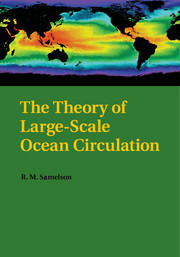Book contents
- Frontmatter
- Contents
- Preface
- 1 Basic Physical Principles and Equations
- 2 Reduced Equations for Large-Scale Motion
- 3 Planetary Geostrophic Vorticity Dynamics
- 4 Stratified Large-Scale Flow
- 5 Circulation in a Simple Rectangular Basin
- 6 Eddy-Driven Subsurface Motion
- 7 Circumpolar Flow
- 8 Mid-Depth Meridional Overturning
- 9 Thermohaline Effects
- 10 Theory and Observation
- Exercises
- References
- Index
7 - Circumpolar Flow
Published online by Cambridge University Press: 07 October 2011
- Frontmatter
- Contents
- Preface
- 1 Basic Physical Principles and Equations
- 2 Reduced Equations for Large-Scale Motion
- 3 Planetary Geostrophic Vorticity Dynamics
- 4 Stratified Large-Scale Flow
- 5 Circulation in a Simple Rectangular Basin
- 6 Eddy-Driven Subsurface Motion
- 7 Circumpolar Flow
- 8 Mid-Depth Meridional Overturning
- 9 Thermohaline Effects
- 10 Theory and Observation
- Exercises
- References
- Index
Summary
The Geostrophic Constraint
Suppose now that the basin geometry is altered from the simple, closed domain considered in the preceding chapters to contain a representation of the circumpolar connection that exists around Antarctica in the Southern Ocean. The simplest such representation is a periodic, reentrant zonal channel in the southern portion of an otherwise closed southern hemisphere domain, with width comparable to that of the opening between South America and Antarctica at Drake Passage (Figure 7.1). Even if the channel is partly blocked by a sill along the domain boundary at some depth above the basin bottom, this is a highly idealized geometry: in the Southern Ocean, much of the latitude-depth cross section of the Drake Passage opening is obscured at other longitudes by islands or shallow bottom topography, which can be anticipated to have a strong influence on both the circumpolar and the meridional flow. Nonetheless, this geometry allows the exploration of several fundamental elements of the effect of the circumpolar connection on the large-scale flow.
Let the periodic zonal channel representing the circumpolar connection cover the latitude range [y-, y+] and the depth range [-Hs, 0], where Hs ≤ H0 is the depth of the sill at x = xE or x = xW. In the channel opening, periodic boundary conditions apply, and the points at x = xE and x = xW are identified, so that ϕ(x = xE) = ϕ(x = xW) for any dynamical variable ϕ.
- Type
- Chapter
- Information
- The Theory of Large-Scale Ocean Circulation , pp. 112 - 127Publisher: Cambridge University PressPrint publication year: 2011



